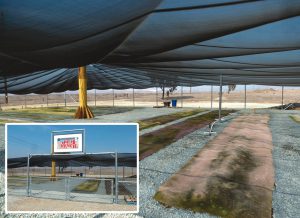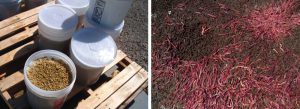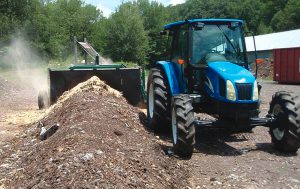An innovative mid-scale vermiculture system helps a state prison in San Diego County, California, save over $100,000 annually.
Rich Flammer
BioCycle May 2014

The vermicomposting system at the
Richard J. Donavon Correctional Facility contains twelve 4-foot wide by 45-foot long worm beds that process 3 to 6 tons of food scraps generated monthly by the facility. Worm beds are covered with used carpet to hold in moisture, prevent overexposure to sunlight and keep out pests, such as fruit flies.
The 780-acre Richard J. Donovan Correctional Facility (RJD), the only state-run prison in San Diego County, California, houses 3,500 inmates, primarily from San Diego and Imperial Counties. One of the California Department of Corrections and Rehabilitation’s (CDCR) 33 adult correctional institutions, RJD is classified as a minimum to high custody facility. It has 1,500 employees.
RJD began a vermicomposting operation, named the Rock Mountain Worm Ranch, in April 2011. Initially, preconsumer food scraps were collected from one of the five kitchens and placed into two 4-foot wide by 45-foot long beds. To house the operation, a 7,500 square foot area was graded and improved with road base to allow for drainage and mitigate any potential storm water issues. A connection was plumbed into the local water supply, and the area was fenced in for site security and personnel safety. The facility was roofed in shade cloth for sun and rain protection of the beds. Low flow emitters to ensure adequate windrow moisture were also installed.
After shopping around and visiting several vermiculture operations, facility developer Ross Lee, RJD Recycling Manager and Hazardous Materials Specialist at the time (he has since moved into construction management for the CDCR), decided to purchase approximately 120,000 blue worms (Perionyx excavatus) for $1,800 from Nature’s Big Bud Worm Castings in Campo, a vermiculture business located in in the eastern part of San Diego County. “Eisenia fetida is the species of earthworm most commonly used in the United States for vermicomposting,” explains Rhonda Sherman, extension specialist at North Carolina State University and vermicomposting expert. “The breeding and growth rate of Perionyx excavatus earthworms is greater than that of Eisenia fetida, but they are temperamental and more likely to leave the bin.” Facility operators haven’t had any problems with worms leaving beds or dying, and haven’t had to purchase any additional ones… a testament to the system’s conscientious management.
Fencing, the shade cloth support structure (including the boom of an old crane), and food grade buckets used for collecting the food scraps were all scavenged from around the facility. With the exception of the worms, the shade cloth, purchased for about $3,500, was the only real capital expense associated with development of the facility. Used carpet is picked up for free from local installers and placed over worm beds. “The carpet holds in moisture, keeps out light, and discourages fruit flies,” notes Sherman. “It also helps keep the bins warmer, which is necessary because the tropical species blue worms being used can perish below 50°F.”
While initial “buy-in” from facility management took time, Warden George A. Neotti stood fully behind the project, and ensured resources, including inmate labor and funding, were made available on a timely basis once program implementation was approved.

Each worm bed is able to process 500 to 600 lbs of food scraps every 2 to 3 weeks. (4) The current estimate for the number of worms (in total) is over four million.
Rapid Expansion, High Diversion
The number of worm beds quickly grew from 2 to 12 as more kitchens were brought online, and in two years, the amount of food scraps diverted doubled from 7 tons in 2011 to 15 tons in 2012. With each of 12 beds able to handle 500 to 600 lbs of food scraps every 2 to 3 weeks, the facility has the capacity to process the 3 to 6 tons generated every month. The current estimated blue worm population is over four million. Diversion tracking includes inmates marking down how many buckets of food scraps are placed in a bed, with each 5-gallon bucket weighing approximately 25 lbs. With the exception of citrus and fats, oils and grease (FOG), all other food scraps are collected and delivered to the worms.
Collection currently involves both preconsumer or prep scraps as well as postconsumer (plate scrapings) being deposited into 5-gallon buckets by kitchen staff, sealed with a lid after full, and moved to the RJD’s central kitchen. From there they are placed on a pallet and transported to the composting area.
Low-level security inmates work on the vermicomposting program, adding food scraps, watering beds, and washing buckets. Incorporation of food scraps into beds is accomplished by pulling the carpet back, making two troughs on each side of the row, adding food scraps and shredded cardboard or grass clippings as a bedding material, pulling the carpet back over the bed, and watering the entire row. Although initially fitted with irrigation hoses running the length of beds on top of carpets, removing and replacing hoses became too time consuming for staff available, so management switched to hand watering about twice a week to maintain adequate internal moisture. Castings have yet to be harvested but potential uses include improving soil onsite, selling them and incorporating them into a vegetable garden tended by inmates.
Cost Savings
Food scraps diversion, in conjunction with other recycling programs, helps to reduce weekly trash collection a full two days (from 7 to 5 days), and saves the prison over $100,000 annually. Operational costs are only the water used, and through installation of meters, management is in the process of determining exactly how much is required and what the associated expenses are.
After Lee moved on, the program was taken over by Mark Gomes, Procurement & Services Officer II, who is a strong proponent of resource management and sustainability. “I love it,” exclaims Gomes. “It’s a great program and saves the prison a lot of money. I also feel it’s very important, especially for this region. But I’d also like to explore ways to reduce food waste at the source, thus reducing what we have to collect and compost.”
Challenges include a high turnover of facility workers and the need for frequent retraining, as the low risk inmates assigned to the operation typically have short prison terms, and budget cuts have reduced availability of guard time to watch them. While relatively easy to operate, the program does need consistent maintenance or the worms will die. But as previously mentioned, no new worms have had to be purchased and the program has been managed exceptionally well.
Since vermicomposting began at RJD, other recycling and resource conservation initiatives have evolved over the same time, including sending eight dumpsters a week of expired or spoiled bakery items for animal feed, and recycling of commingled paper, plastic and cardboard, textiles, nonferrous metals, and mattresses. These diversion methods generate disposal savings and revenue, as well as educational opportunities for inmates. In addition to the hands-on experience they get operating the vermiculture operation, RJD offers related studies in the areas of Recycling and Green Industries and Food Handling. These skills can help improve inmates’ chances of being hired in the ever-growing sectors of sustainability and resource management.
Rich Flammer, a composting consultant, is a Contributing Editor to BioCycle.














